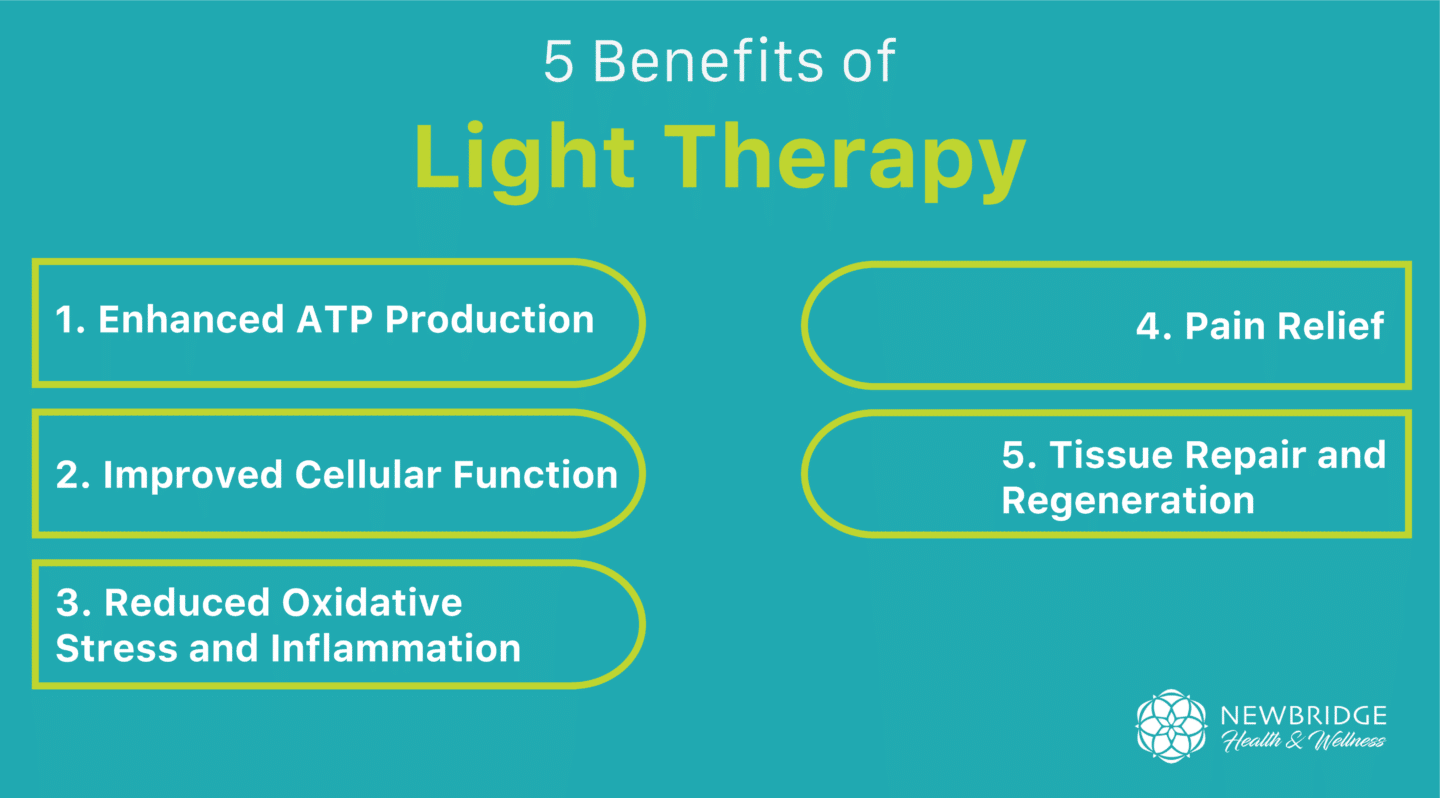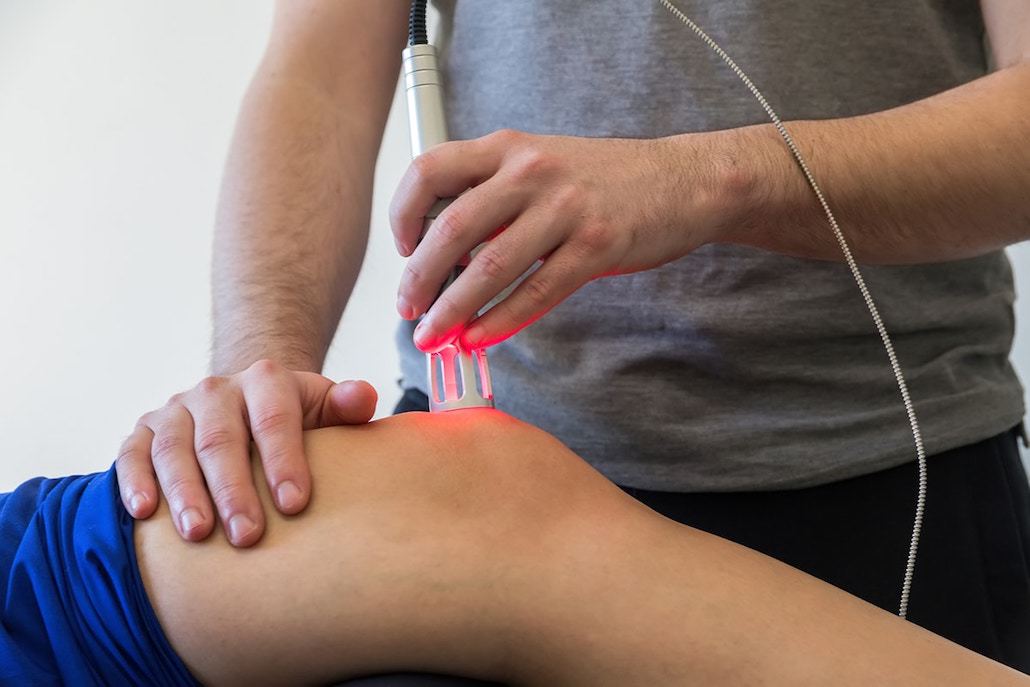What is Light Therapy?
Low-level light therapy or cold laser therapy – more commonly referred to as Photobiomodulation (PBM) in clinical settings – is a non-invasive therapeutic approach that utilizes specific wavelengths of light to stimulate cellular function and promote various physiological effects in the body. The term “photobiomodulation” reflects the process by which light energy interacts with biological tissues, leading to modulation and optimization of cellular functions.
PBM typically involves the use of low-intensity lasers or light-emitting diodes (LEDs) that emit specific wavelengths of light. These wavelengths can range from visible light, such as red and near-infrared (NIR) light, to other parts of the electromagnetic spectrum. The choice of wavelength depends on the desired therapeutic effect and the targeted tissues identified by a health provider.
In this blog post, we delve into the science behind photobiomodulation, and later explore the specific applications and advantages of two forms of this light therapy – 635nm and 810nm light.
Interested in light therapy? We offer both sophisticated LED and laser applications for health, healing and beauty/skin-care, and anti-aging. Call our clinic at (612) 730-2237 to learn more and to make an appointment!
How/Why does PBM help the body?

When light energy is applied to the skin or other body tissues, it is absorbed by chromophores within the cells. Chromophores contribute to the color and light-absorbing properties of different parts of the body and are found within the mitochondria of cells.
The interaction between light and tissues at the cellular level can lead to a range of beneficial effects, including reduced inflammation, enhanced tissue repair, improved circulation, and pain relief. Here is a deeper look at how light therapy interacts with the body to activate healing:
1. Enhanced ATP Production: PBM stimulates the production of adenosine triphosphate (ATP), the energy currency of cells. Increased ATP levels can promote cellular metabolism and provide energy for various cellular processes.
2. Improved Cellular Function: PBM can influence cellular signaling pathways, gene expression, and protein synthesis. It may enhance cell proliferation, stimulate the production of growth factors, promote angiogenesis (formation of new blood vessels), and modulate inflammatory responses.
3. Reduced Oxidative Stress and Inflammation: PBM has been shown to have anti-inflammatory and antioxidant effects. It can help reduce oxidative stress, counteract the production of reactive oxygen species (ROS), and modulate inflammatory mediators, thereby promoting tissue healing and reducing inflammation.
4. Pain Relief: PBM has analgesic properties and can help alleviate pain by modulating pain receptors, promoting the release of endogenous opioids, and reducing inflammation. It is commonly used for pain management in various conditions, such as musculoskeletal injuries, neuropathic pain, and chronic pain syndromes.
5. Tissue Repair and Regeneration: PBM can enhance tissue repair processes, including wound healing and tissue regeneration. It promotes collagen synthesis, accelerates epithelialization, and supports the formation of new blood vessels, leading to improved tissue recovery.
How is PBM used in clinical settings?
PBM is a versatile therapy with potential applications in various fields, including healthcare, sports medicine, dermatology, and neurology. Among the diverse spectrum of light used in PBM, the wavelengths of 635nm and 810nm have emerged as key players in clinical settings for unlocking the remarkable benefits of this technology.
The Power of 635nm Light
The wavelength of 635nm falls within the red light spectrum, making it highly effective in PBM applications. Red light at this wavelength has been shown to have a profound impact on cellular activity and can penetrate the skin to reach deeper tissue layers. Here are some key benefits associated with 635nm light:
1. Enhanced Skin Health: 635nm light has been found to stimulate collagen production, promote cellular regeneration, and improve skin elasticity. It can aid in reducing the appearance of wrinkles, fine lines, and age spots, resulting in a more youthful complexion.
2. Pain Relief and Inflammation Reduction: When applied to inflamed or injured areas, 635nm light can help alleviate pain and swelling by promoting the release of endorphins and modulating inflammatory responses. This makes it useful for managing conditions such as arthritis, sports injuries, and chronic pain.
3. Wound Healing: Studies have shown that 635nm light can accelerate wound healing by stimulating cell proliferation, enhancing angiogenesis (the formation of new blood vessels), and increasing collagen synthesis. It can be particularly beneficial for diabetic ulcers, burns, and surgical wounds.
The Benefits of 810nm Light
The wavelength of 810nm lies in the near-infrared (NIR) spectrum, and it is known for its ability to penetrate tissues more deeply than other visible light wavelengths. Here are some key advantages of 810nm light in PBM:
1. Pain Management: 810nm light can penetrate deep into the muscles and joints, making it effective for managing chronic pain conditions such as fibromyalgia, back pain, and neuropathy. It helps reduce inflammation, improves blood flow, and promotes the release of endogenous opioids, providing pain relief.
2. Muscle Recovery and Performance Enhancement: Athletes and fitness enthusiasts can benefit from 810nm light therapy, as it has been shown to enhance muscle recovery, improve muscle strength, and reduce exercise-induced muscle fatigue. This makes it a valuable tool for optimizing sports performance and preventing injuries.
3. Neurological Applications: Research suggests that 810nm light can have positive effects on the central nervous system. It has shown potential in the treatment of neurodegenerative disorders like Alzheimer’s and Parkinson’s diseases, as well as neurological conditions such as stroke and traumatic brain injury. The therapy promotes neuroprotection, enhances cerebral blood flow, and supports neuronal survival.
Did you know? PBM can be administered through continuous exposure or by way of pulsing different light frequencies. Pulsing has been shown in some studies to me more helpful than continuous exposure, depending on the reason a person is being treating. At Newbridge, our laser uses pre-set pulsed PBM, and we can customize protocols as needed, based on current data and a patient’s needs. Contact us today to learn more and to see how this therapy can help you heal!
How is PBM helping people with neurodevelopmental conditions like ASD?
Photobiomodulation is being explored as a potential therapy for neurodevelopmental conditions like autism spectrum disorder (ASD). While research in this area is still evolving, preliminary studies suggest that PBM may have positive effects on certain symptoms and behaviors associated with autism. Here’s an overview of how PBM is being investigated in the context of neurodevelopmental conditions:
1. Cognitive Function and Behavior: PBM studies in autism focus on improving cognitive function, communication skills, social interaction, and reducing behavioral symptoms. Light therapy applied to specific areas of the brain may help modulate neuronal activity, potentially leading to positive behavioral changes. Some studies have reported improvements in attention, language skills, social responsiveness, and reduced repetitive behaviors following PBM interventions.
2. Brain Connectivity and EEG Patterns: PBM’s effects on brain connectivity and electroencephalogram (EEG) patterns are also of interest in autism research. Functional connectivity studies using neuroimaging techniques have shown alterations in brain network connectivity patterns in individuals with ASD. PBM has been investigated as a means to potentially modulate these patterns and restore more typical connectivity.
3. Oxidative Stress and Inflammation: Oxidative stress and neuroinflammation have been implicated in the pathophysiology of autism. PBM’s ability to reduce oxidative stress and inflammation is of interest in this context. Studies have shown that PBM can modulate immune responses, reduce inflammation markers, and promote antioxidant mechanisms. These effects may contribute to improved neurodevelopment and reduced symptom severity in autism.
It’s important to note that research on PBM in neurodevelopmental conditions like autism is still in its early stages, and larger-scale clinical trials are needed to establish its effectiveness and optimal treatment parameters. Factors such as the choice of light parameters (wavelength, intensity, duration), treatment frequency, and individual variability can influence the outcomes.
Are there hospitals in the USA using photobiomodulation?
Numerous hospitals across the United States have already incorporated PBM into their treatment protocols. Here are a few notable examples:
1. Massachusetts General Hospital (MGH): MGH, located in Boston, Massachusetts, is one of the leading hospitals in the country. It has been at the forefront of integrating PBM into its clinical practices. The hospital has employed PBM for various applications, including wound healing, pain management, and neurological conditions.
2. Cleveland Clinic: Cleveland Clinic, based in Cleveland, Ohio, is renowned for its advanced medical treatments. It has embraced PBM as a non-invasive therapy option for pain management and wound healing. The clinic utilizes PBM devices in certain departments and research initiatives.
3. Mayo Clinic: Mayo Clinic, with its campuses in several states, including Minnesota, Arizona, and Florida, is another prestigious medical institution using PBM. Mayo Clinic incorporates PBM into its pain management programs, particularly for conditions such as fibromyalgia, chronic headaches, and musculoskeletal pain.
4. Stanford Medicine: Stanford Medicine, associated with Stanford University, is highly regarded for its cutting-edge research and clinical care. It has incorporated PBM into its pain management strategies and has explored its potential for treating conditions like peripheral neuropathy and chronic musculoskeletal pain.
5. Laser Therapy Center at North Shore Medical Center: The Laser Therapy Center, located at North Shore Medical Center in Massachusetts, specializes in providing PBM treatments. It offers therapy options for pain management, wound healing, and dermatological conditions.
The use of PBM varies across hospitals and their departments, and its availability might depend on specific medical conditions and treatment plans. It’s advisable to contact hospitals directly to inquire about the availability of PBM treatments for different medical diagnoses.
Want to learn more about photobiomodulation? If you or someone you know is interested in exploring PBM as a potential therapy, call our clinic at (612) 730-2237 to learn more!


